Irradiation Effects on Ferritic Martensitic Steels: Part Two
Abstract
The irradiation hardening is caused by the high density of dislocation loops and tangles that form from displacement damage, along with irradiation-induced precipitate changes. This hardening causes a decrease in ductility. Irradiation hardening also affects other properties, such as fatigue and toughness.
Effect of Irradiation on Mechanical Properties
The effect of irradiation on the tensile behavior of the 7–12% Cr ferritic/martensitic steels depends on temperature. Hardening, as measured by an increase in yield stress and ultimate tensile strength (Figure 2), occurs at irradiation temperatures up to 425-450°C.
The hardening causes a decrease in ductility (Figure 3). This irradiation hardening is caused by the high density of dislocation loops and tangles that form from displacement damage, along with irradiation-induced precipitate changes. Hardening saturates with increasing fluence, and saturation occurs by 10 dpa. For irradiation above 425–450°C, properties are generally unchanged (Figures 2 and 3), but there may be enhanced softening, depending on fluence. At these temperatures, microstructures change slowly through dislocation recovery processes and precipitates coarsening. Irradiation enhances diffusion and/or precipitate redistribution, which can enhance recovery and coarsening, and thus, increase the rate of softening.
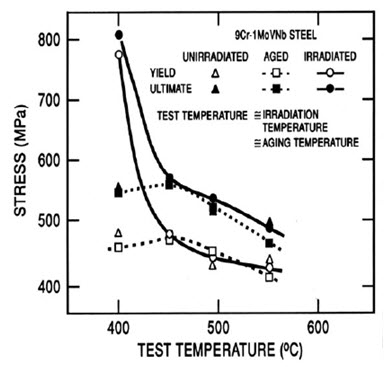
Figure 2: Yield stress and ultimate tensile strength of normalized-and-tempered, thermally aged, and irradiated modified 9Cr-1Mo (9Cr-1MoVNb) steel. Irradiation was in EBR-II to 9 dpa.
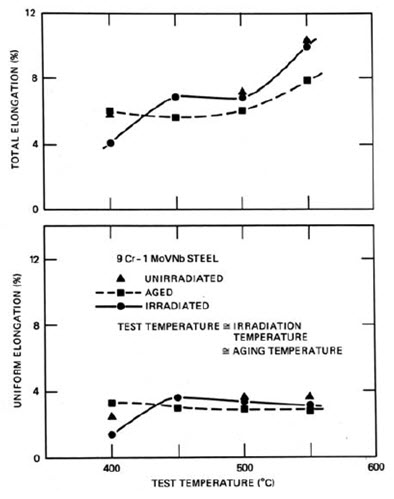
Figure 3: Uniform and total elongation of normalized-and-tempered, thermally aged, and irradiated modified 9Cr-1Mo (9Cr-1MoVNb) steel. Irradiation was in EBR-II to 9 dpa.
Irradiation hardening affects other properties, such as fatigue and toughness. The latter is of considerable concern and will be discussed briefly. Irradiation effects on toughness are the greatest concern for fusion applications of ferritic/martensitic steels and for pressure-vessel steels for light-water reactors. The effect is observed in a Charpy impact test as an increase in ductile-brittle transition temperature (DBTT) and a decrease in upper-shelf energy (USE), 45-50 as shown in Figure 4 for HT9 irradiated in FFTF. As seen in the figure, the shift saturates with fluence (the shift is the same after 10 and 17 dpa).
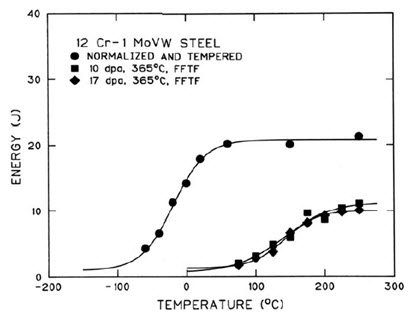
Figure 4: Charpy curves for half-size specimens of Sandvik HT9 (12Cr-1MoVW) steel before and after irradiation to 10 and 17 dpa at 365°C in FFTF.
The magnitude of the shift varies inversely with irradiation temperature. Although all 7–12% Cr conventional and reduced-activation steels irradiated to date to high displacement damage (>100 dpa) demonstrate this effect on toughness, there are differences among different steels, as shown in Figure 5, where the shift in DBTT for HT9 is compared with the shift for reduced-activation ORNL 9Cr-2WVTa steel.
The reduced-activation steel showed much less shift (about 10°C vs. 125°C). Part of this difference was attributed to the larger carbon concentration in the HT9 (0.2%) than the 9Cr-2WVTa (0.1%); the tantalum in the 9Cr-2WVTa has also been shown to have a favorable effect on the impact properties. Modified 9Cr-1Mo (T91) has a DBTT shift about half as large as HT9 for similar test conditions, which is still more than twice that for the 9Cr-2WVTa steel.
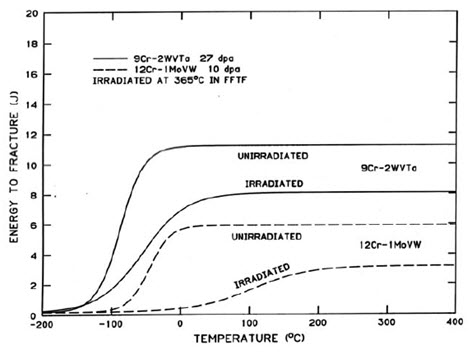
Figure 5: Comparison of the unirradiated and irradiated Charpy curves for one-third-size specimens of HT9 and ORNL 9Cr-2WVTa steels irradiated in FFTF at 365ºC.
The effect of irradiation on the shift can be affected by the normalizing-and-tempering treatment and by the processing used on the steel during manufacture. It has been demonstrated that part of the reduction in USE on the MANET steel can be recovered by annealing 0.5 h at 535°C. Such an annealing would dissolve irradiation induced defects, particularly tiny clusters and dislocation loops that lead to hardening. The above discussion on embrittlement concerned high-chromium steels and irradiations to high displacement damage (>1 dpa). In the pressure vessel steels of the light-water reactors (e.g., A533 B) operating today, hardening and embrittlement in these low-alloy steels are observed for irradiations of <1 dpa, where there is little effect on the high-alloy steels.
As measured by a shift in DBTT in Charpy tests, there are indications that transmutation helium increases the embrittlement of the higher-chromium steels in a fusion neutron environment after irradiation in the hardening range (below ≈425°C). However, because of the much lower amount of helium formed in fission light-water and fast reactors, such as the Generation IV designs, helium should not be a factor for this type of embrittlement in those reactors.
Intergranular low-ductility fractures attributed to helium effects are observed in tensile tests of austenitic stainless steels for irradiation temperatures Ti ≥ 0.5Tm, where Tm is the melting temperature (temperatures in Kelvin). Such elevated-temperature helium embrittlement in austenitic stainless steels can occur with as little as 1 ppm He or less, depending on the composition, thermomechanical processing, irradiation conditions, and test conditions (temperature, strain rate, etc.). All indications are that the ferritic/martensitic steels are relatively immune to this type of embrittlement.
Find Instantly Precise Material Properties!
Total Materia Horizon contains physical, thermal and electrical properties for hundreds of thousands of materials, for different temperatures, and much more.
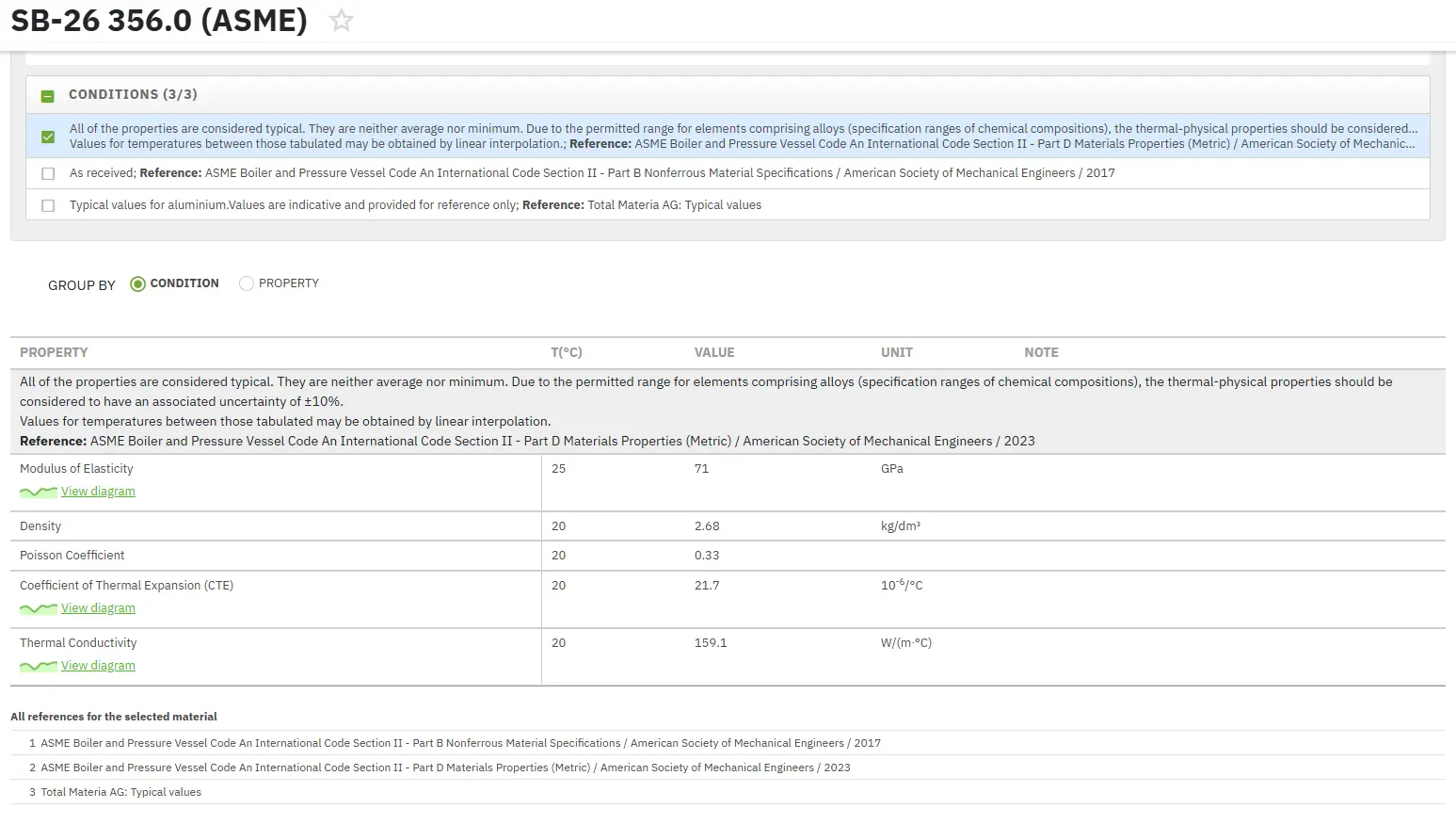
Get a FREE test account at Total Materia Horizon and join a community of over 500,000 users from more than 120 countries.